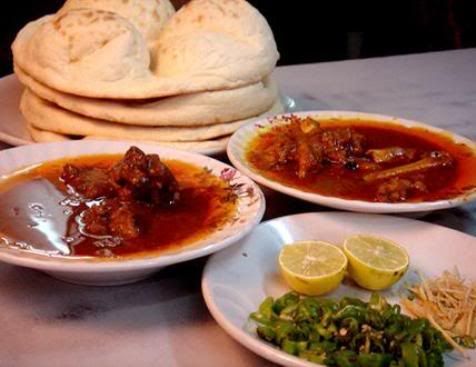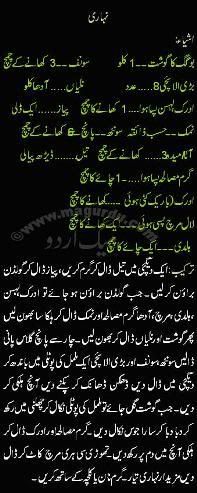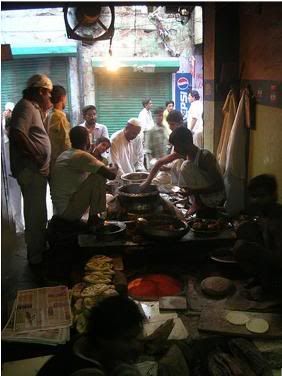Mohammad Ayaz Abdal
It was a very captivating scene. My friend Andrew, a born Britisher who as a kid moved to Canada, eating Nihari with full zeal and devotion…..and this was his first time. I never thought that anybody from this part of the world can not only taste Nihari but also enjoy it. This dish whose story goes back about 200 years has now conquered the world rising from the city of Dilli. (the name old Dilli walla use for Dehli)

My mind went back to its origins. Ashraf Saboohi, in his very interesting book Dilli ki chand ajeeb hastiyan wrote:
“We have heard from our elders that when Saadat Khan cleaned the Shah Jehani Nehar (Canal) and it started flowing again in the middle of Dehli, Alvi Khan Hakeen wore the funeral dress and entered the Court. When king Mohammad Shah asked the reason he said, I am crying over the lost health of the city. Disease will now become rampant. When asked about the cure, he advised increasing the use of Red Chillies and Khataai (I do not know its English translation). In order to reduce the effects of these heavy duty spices, it was recommended to add pure ghee.â€
 So the king ordered the cook to design a dish as per the Hakeem’s specifications. It is actually a type of Qorma where only beef shank meet is used. Fried onions, hot ghee, lemon, slices of garlic and coriander leaves are used as dressing and it is served with hot naan bread. Bone marrow and goat brain are added delicacy. (I have seen people adding makhan ka baghar (fried butter) also). After the dish it was customary to eat Gajar ka halwa (Carrot pudding) to reduce the effects of spices. At Burns road in Karachi, all the good halwa and rabri shops were next to Nihari shops. I don’t know whether they now exist or not. After reading the above paras, you would have guessed correctly that coronary disease was not discovered or was not given much thought during those days.
So the king ordered the cook to design a dish as per the Hakeem’s specifications. It is actually a type of Qorma where only beef shank meet is used. Fried onions, hot ghee, lemon, slices of garlic and coriander leaves are used as dressing and it is served with hot naan bread. Bone marrow and goat brain are added delicacy. (I have seen people adding makhan ka baghar (fried butter) also). After the dish it was customary to eat Gajar ka halwa (Carrot pudding) to reduce the effects of spices. At Burns road in Karachi, all the good halwa and rabri shops were next to Nihari shops. I don’t know whether they now exist or not. After reading the above paras, you would have guessed correctly that coronary disease was not discovered or was not given much thought during those days.
The Nihari wala that has been mentioned by every Dilliwala was Ganja Nihari wala who took the preparation of this dish to an art. During those times, Nihari was more of a winter dish. It was not available throughout the year as it is now. It used to be eaten early in the morning. It was especially liked by the poor as this food is enough for them till dinner. It was cheap during those days and skipping lunch would save money for them. Rest of the year, these Nihari walas used to sell other dishes but not Nihari.
The making of Nihari was an art. As per Ujjra Dayar By Shahid Ahmed Dehlvi (grandson of Deputy Nazir Ahmed:
“Usually a hole was dug near the shop where the pot was put into with a window below to put the coal in. After putting all the spices and meat, it used to be cooked for the whole night. The tradition was to eat Nihari at the shop. There is only one daig or pot. So whoever comes early, rich or poor will get the order. Once it is finished, you have to wait till the next day. “
 This reminds me of my childhood. Our Nihari wala was Sagheer from Dehli Muslim hotel (not the Kalia) at Burns Road. Sagheer and our family go a long way. His grandfather used to be our family bawarchi (cook for special occasions) and served my great great grandfather. We were totally prohibited from buying Nihari from any other place. Nihari was only ordered in winter and also only for breakfast. Usually on a Wednesday, Sagheer was called and was told that we will be having Nihari for the weekend. On Saturday evening, my uncles would leave our pateelas (pots) at his shop. Sunday morning, one of them usually wakes up quite early to make the trip to the shop. We try to wake up too to join him. There Sagheer would use to fill our order himself rather than the servant as taking out the Nihari was regarded as an art. He knows who in our family like adla and who wanted reshay wali boti. Nalis and bhejas was wrapped separately along with the Naans. On our return home, the big dastar khawan (eating mat) was spread in our big room. Special newly polished copper plates (Qalai wali rakabi) were used to eat Nihari. My grandmother and mother would have already made the baghar (hot oil) that used to be put on the Nihari. It used to be warmed again. Our old servant Bahadur Ali used to warm the naans on our angheeti (coal fired stove). We used to sweat during those early winter mornings due to the warmth and spices of that Nihari. There was no lunch and a very light dinner (usually Kichri) was served in the evening.
This reminds me of my childhood. Our Nihari wala was Sagheer from Dehli Muslim hotel (not the Kalia) at Burns Road. Sagheer and our family go a long way. His grandfather used to be our family bawarchi (cook for special occasions) and served my great great grandfather. We were totally prohibited from buying Nihari from any other place. Nihari was only ordered in winter and also only for breakfast. Usually on a Wednesday, Sagheer was called and was told that we will be having Nihari for the weekend. On Saturday evening, my uncles would leave our pateelas (pots) at his shop. Sunday morning, one of them usually wakes up quite early to make the trip to the shop. We try to wake up too to join him. There Sagheer would use to fill our order himself rather than the servant as taking out the Nihari was regarded as an art. He knows who in our family like adla and who wanted reshay wali boti. Nalis and bhejas was wrapped separately along with the Naans. On our return home, the big dastar khawan (eating mat) was spread in our big room. Special newly polished copper plates (Qalai wali rakabi) were used to eat Nihari. My grandmother and mother would have already made the baghar (hot oil) that used to be put on the Nihari. It used to be warmed again. Our old servant Bahadur Ali used to warm the naans on our angheeti (coal fired stove). We used to sweat during those early winter mornings due to the warmth and spices of that Nihari. There was no lunch and a very light dinner (usually Kichri) was served in the evening.
 Now when I look back all those characters are gone. Sagheer died quite early and his hotel is gone. I think he had a kidney transplant operation in India and became quite famous as he was one of the earlier Pakistanis who had this kind of a procedure over there. His interview was even published in Akhbar-e-Jahan, if my memory serves me right. We started buying Nihari from Waheed hotel and also tried from Malik’s. They were good but not like Sagheer. We used to laugh at Sabri’s. We used to call it the spice less or sick man’s Nihari. Then came the big revolution where Nihari Inns were opened at every corner and it became a dish of all seasons. I remember when we first looked at Nihari at a wedding reception, we were quite
Now when I look back all those characters are gone. Sagheer died quite early and his hotel is gone. I think he had a kidney transplant operation in India and became quite famous as he was one of the earlier Pakistanis who had this kind of a procedure over there. His interview was even published in Akhbar-e-Jahan, if my memory serves me right. We started buying Nihari from Waheed hotel and also tried from Malik’s. They were good but not like Sagheer. We used to laugh at Sabri’s. We used to call it the spice less or sick man’s Nihari. Then came the big revolution where Nihari Inns were opened at every corner and it became a dish of all seasons. I remember when we first looked at Nihari at a wedding reception, we were quite
shocked. That was the age of innocence.
So Nihari has moved from the Bhatyaras of Dilli to the Sabri hotel at Chicago. It has lost a bit of spice in the transformation but it has still regained the numero uno position (at least in my heart) of the dishes from our part of the world. It still dazzles the palate, and sometimes the digestive systems, from people of all color and nations.




















































Since my childhood I have heard atleast five different version of this gudha gosht nihari. From Bara Maidan, Paposh to Saddar to Javed Nihari —-every single one has been accused atleast once of lacing their niharis with Ghuda Goosht.
But, I think with turnover which might even put some serious IT engineers and US based family physicians to shame—I doubt to this day that Ghuda Goosht was a reality rather than a urban old wives tale.
I mean where the *(& would you get the donkey gosht from????
Shame on you though —-to make us miss and our mouth salivate by teasing pics of the authentic Karachi Nihari. In sub minus temperatures here, its cruel to talk about Nihari back home.
@Rashid Ali, Shahnawaz chain of California also offers ‘chicken nihari’. For more than a year I was a regular visitor at their San Jose branch for lunch buffets where they used to serve chicken nihari as ‘eat all you can’ and people indeed ate (rather drank) all they could of that nihari.
Mohammad Ayaz Abdal, you have touched my taste buds with talk of Burns Road or Dehli mUSLIM Hotel Nehari of Karachi. Alas, the taste of Modern Nehari in Karachi, Dubai, Qatar, London, Houston, Los Angeles just does not taste the same. I have tried Nehari in all of these locations extensively. Shaan Masala has turned every house wife into Nehari experts which has lost the traditional cooking method of all night Daigh cooking. To make things worse the old traditions and etiquets of eating Nehari have gone. Nehari is now available all day and night instead of being breakfast/morning dish. Nehari is served in house dinner parties with numerous other dishes. Nehari mixed with Biryani or other dishes is truly a sacrilege of culinary art. This is just one symbol of the decilne of our glorious gastronomic heritage and culture. All I can do now is reminisce and complain. YAAD – E MAAZI AZAB HAY YA RUBB, CHHEEN LAY MUJH SAY HAFIZA MERA
P.S. Lat week I ate Nehari at Shahnawaz restaurant in Los Angeles. The Nehari is recommended and was fairly good but nothing like the Nehari of old Karachi. I congratulated the chef, who was from Karachi, on his Nehari and asked him the same old question I ask all Nehari chef. You guessed it “why is the Nehari doesn’t taste the sane as that of old Karachi. This time I finally got the truth from an expert chef and I would like to share it with all readers. The chef answered “Today Masala, Ghee or oil is pure. We cannot recreate the same taste of old Jaali Masla and Mobil oil cooking”
@nihari – you made me laugh out loud on your anecdote of how you avoided eating ‘maghaz’ amidst the ‘gadha gosht’ scandal before exams :) :)
@Nihari – Javed’s nihari in Dastgir society used to be my hang with school friends for many years too.